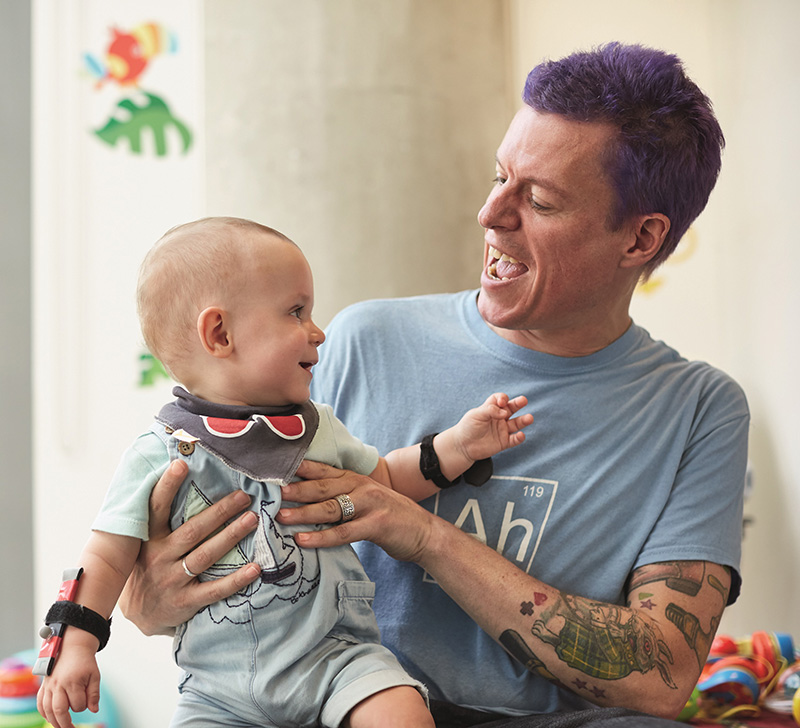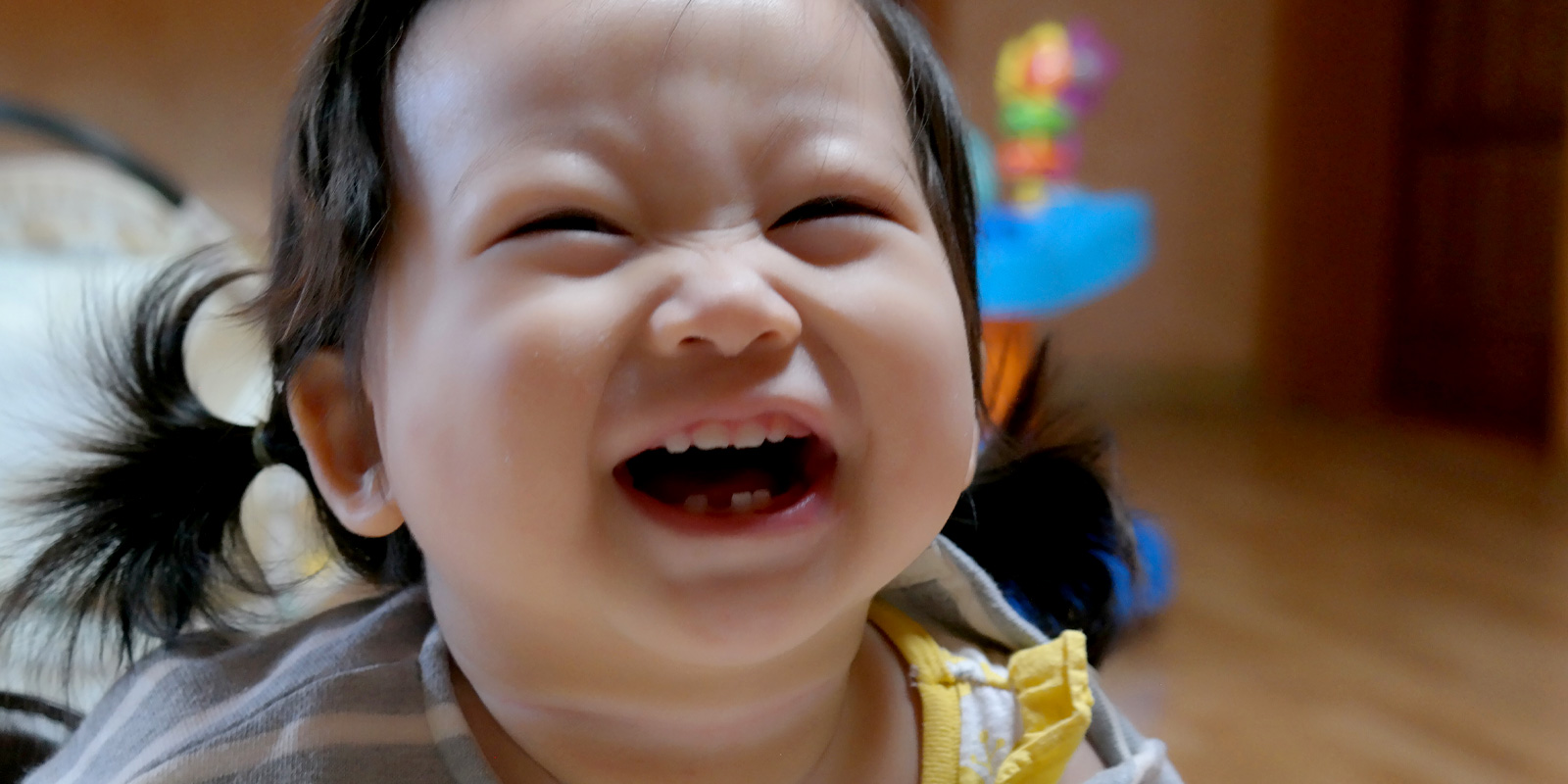The game of peekaboo is a universal language—and there’s way more to it than you might imagine.
You know the game: the big person covers their face with their hands or ducks out of sight. They’re gone! They suddenly reappear and say, “Boo!” and the baby is delighted. This delight delights the big person, who does it again. Hilarity ensues; rinse, repeat, in a social interaction that, though nonverbal, is the back-and-forth, call-and-response of baby’s first conversational turn.
For nearly a decade, baby psychologist Dr. Caspar Addyman has run the Baby Laughter project for the University of London’s Babylab, collecting videos, stories and data from parents all over the world. His book, The Laughing Baby: The Extraordinary Science Behind What Makes Babies Happy, is a popular science book about baby psychology—a field that is much more sparsely populated than it ought to be, given the fact that babyhood is every human’s foundation for being in the world. In fact, realizing that is what led Addyman to be a baby psychologist in the first place.
“I picked babies because that seemed like the best place to start if you’re trying to understand people,” Addyman says. “These are the crucial years. But as academics, we approach our research … academically: ‘When can they say their first word? When do they have their first concept? When can they tell male faces from female?’’’ Researchers are able to test infants’ learning through a tested-and-true method of making the babies bored by showing them the same thing repeatedly, then slipping in something different. For example, dog, dog, dog, dog, then suddenly, cat. In observing his infant niece, he thought he might have stumbled on another means of getting the data, but soon realized that babies only laugh when they get the joke. You can’t fake it with a baby, and they won’t fake it with you (except when they get a bit older and are completely bored with your silly peekaboo and feign a little laugh to be polite. A different story for another time). A stranger popping into a lab and trying to make a baby laugh is, from the baby’s perspective, pretty weird. They have a nose for manipulation and if it isn’t spontaneous? No ignition.

Babies laugh a lot, and most researchers don’t pay attention to that. Psychology has often been more focused on pathology—what’s wrong, what happened and how can it be prevented—rather than really looking at happiness and lives that are flourishing. Addyman decided to take babies’ laughter seriously and soon realized how deep a vein of research gold he had struck.
Humans evolved to be completely helpless at birth. In much of the animal kingdom, within minutes or hours of birth, the young animal is able to stand, walk and keep up to some degree with the group. Human infants have a long period of complete dependency, and during that time it is crucial to their survival that adults care for them through an extended development period. The success of human survival is more than anything social success.
“It really does take a village to raise a child,” Addyman says. “When we were hunter-gatherers in the African savannah, it took the whole village to survive as a group and raise every child. The success within that is getting on with everybody else.” It pays for a helpless little creature to be beguiling: smiles and laughter are the social lubricant that bind the baby to the group.
As survival strategies go, beguiling is a great one. The act of nursing, having one’s diaper changed or playing peekaboo, create delicious opportunities for social bonding. Babies become aware at a very early age of that heady rush when they hold another’s gaze, and they can do so for a surprisingly long time. Think about a time you swapped glances with a potential romantic partner and felt that rush of reward if the glance became mutual, Addyman says. Maintaining that connection is a matter of survival for human infants, and in this case, survival can be a lot of fun.
In fact, he says, researchers have found that the brainwaves of baby and adult become synchronized when there is mutual eye contact. The game of peekaboo is an extension of this mutuality. When the big person goes away briefly, there’s a moment of suspense as the baby wonders what’s happened, where did my person go? When their person pops back into view, the baby is joyful to see them, but also—most important from a developmental perspective—the baby’s hypothesis that they actually were coming back has been supported. Babies are scientists, Addyman says, and their entire existence practically from birth is positing one hypothesis after another. Part of the joy of peekaboo is the triumph of a prediction confirmed. Yesss! I knew she’d pop back up. She always does! We all love being right.
The game of peekaboo starts out very simply and doesn’t even require that the big person completely disappear. With very young babies, the surprise of withdrawing out of the field of vision—not well developed at this point—then coming in close is a big surprise. When the experience is repeated, and the baby observes the big person’s delight at their response, the child quickly catches on and game on! As baby grows, the game grows with them, and by six months, peekaboo is the best game there is, the adults are tweaking their comic timing and the game is rewarded with lots of big people smiles and baby belly laughs.
And babies do belly laugh, though not right away. For ages, psychologists and the medical establishment have held that what looks like smiles in babies younger than six weeks is actually gas and isn’t a communication of any kind. Addyman points out that these same experts have no trouble believing that babies’ crying is a form of communication. Believe the parents, he says: babies smile very early in response to pleasure, and infants three months old and younger, laugh.
“I have videos parents have sent me of much younger babies laughing,” he says, “and it’s a very delicate, breathy sound. It’s not a full guffaw because their lungs aren’t really ready for that. Crying is easy, you just have to go ahhhhhhhh and take a breath and ahhhhhhhh. It’s all one thing. Laughter is an in-out, in-out, ha-ha-ha and it’s harder to achieve.”
The whole time a baby is engaged in this way with the big people is a moment of pure social connection and pure learning for the child, Addyman says. Babies don’t laugh when they’re by themselves; it’s all about the interaction. They’re learning not only from the adults but from themselves. They realize the can do something and it will have a dependable effect. I laugh, Mommy laughs back and hugs me … hmmm. This has promise. It is, he says, their first taste of a sense of agency and they like it.
After more than a decade of studying what makes babies happy, Dr. Caspar Addyman has come up with some simple core lessons for those of us who would like more happiness in our lives. If baby can do it, we can too:
1. Have great, mutually safe relationships in which you let people know you care about them and you allow them to care about you.
2. Keep challenging yourself and achieving new knowledge and skills.
3. Be here now. Babies are little Zen masters for whom the present is all there is—and they are delighted to be here. Be more like babies.
As wonderful as babies’ laughter is, Addyman says, it also has its limits. Babies like things that surprise them; they don’t like actually scary things. Excitement and fear both cause our bodies to react in a similar way, releasing adrenaline and getting our hearts racing. Adrenaline prepares us to react. When the situation turns out not to be dangerous after all, there’s a sense of relief and excess energy to be expended—in a baby belly laugh.
When tickling a baby or paying peekaboo, it’s essential that the adult pay close attention to the child’s reactions. The little one can’t say, “Ok, I’ve had enough now. Lay off.” They may look away or tire of the game, a signal that tears may come soon if their communication isn’t needed.
“Babies are not great at controlling what they can and can’t do,” he says. “So especially with things like tickling, you have to pay proper attention and know when you’re pushing them too far. Laughter means let’s keep this going; tears mean time to stop. The child’s laughter isn’t just a toy for your amusement.
“The best way to make a baby laugh is to take them seriously and remember that all the way through the interaction. You’re not playing the clown to get validation from the baby. That’s definitely a temptation for parents, especially with the mobile phone in their hands.”
Babies find men and women equally funny, according to Addyman’s survey. Nobody scores the highest, though, he says, “Mums might feel like, ‘I’m there more often, so pro rata, shouldn’t I be getting more laughs?’” Though babies do develop their individual tastes, he says his research hasn’t identified any preference for particular members of the family. If someone is playing with baby and they’re laughing, baby is happy.
“One thing I can tell you that’s different from adults,” he says. “Adults find cats very funny. Babies think dogs are hilarious.
“Cats? Not so much.”
RESOURCES
Dr. Addyman’s website features a rabbit-hole’s worth of photos and brief videos of babies laughing, shared by people from around the globe: http://laughingbaby.info.
K.C. Compton worked as a reporter, editor and columnist for newspapers throughout the Rocky Mountain region for 20 years before moving to the Kansas City area as an editor for Mother Earth News. She has been in Seattle since 2016, enjoying life as a freelance and contract writer and editor.




